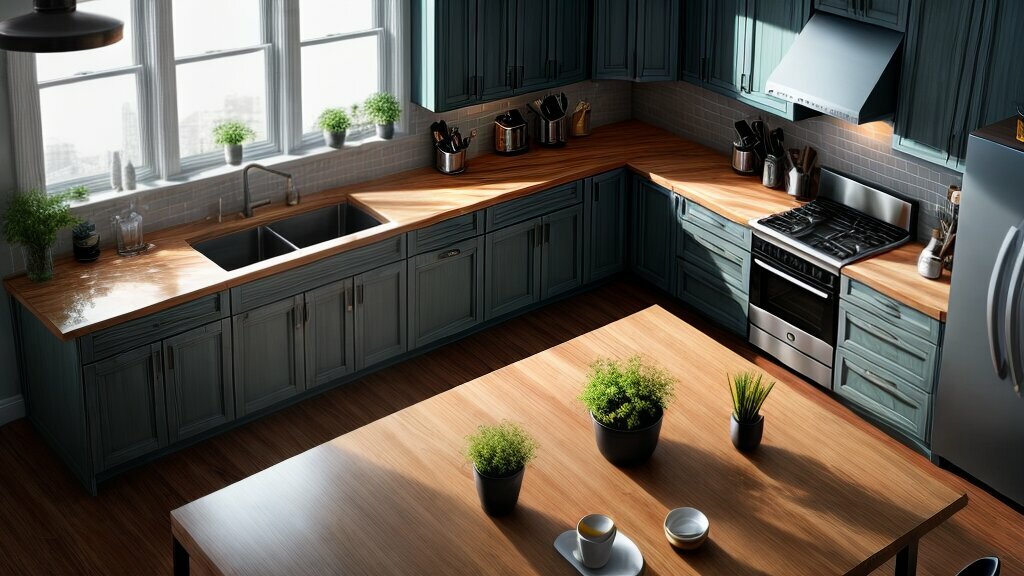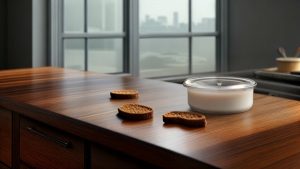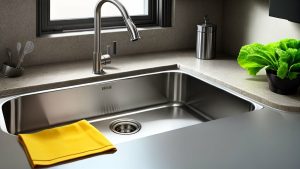Keeping a kitchen spotless is essential, and cabinets are no exception. However, grease stains can build up on kitchen cabinets over time, making them look dull and dirty. Removing these stains can be challenging and intimidating, but with our tips and tricks, you can easily clean off grease from kitchen cabinets and restore their shine.
In this article, we will guide you through the hassle-free removal of grease stains from cabinets. We will discuss the causes of grease buildup, effective cleaning solutions, essential tools, proper cleaning techniques, and preventive measures. By the end of this article, you will have the knowledge and confidence to transform your kitchen cabinets and keep them spotless.
Key Takeaways
- Grease stains can build up on kitchen cabinets over time, making them look dull and dirty.
- Regular cleaning is essential to maintaining your cabinets’ shine.
- Our tips and tricks provide an easy and effective solution for removing grease stains from cabinets.

Understanding the Causes of Grease Buildup on Kitchen Cabinets
As we dive deeper into removing grease from kitchen cabinets, we must understand the common causes of grease buildup. Cooking oils, splatters, and steam are the main culprits of grease stains on cabinets. Over time, these stains can become stubborn and difficult to remove, potentially damaging the cabinet finish.
Regular cleaning is essential to prevent long-term damage and maintain the spotless shine of kitchen cabinets. As grease accumulates over time, it can attract dust and other particles, making cleaning more challenging and time-consuming.
When cleaning grease stains from kitchen cabinets, proper methods and tools are essential to avoid damaging the cabinet finish. Abrasive cleaners and tools should be avoided, as they can leave scratches and other marks on the surface.
Best Ways to Clean Kitchen Cabinet Grease
There are several effective methods to remove grease from kitchen cabinets, depending on the severity of the stain and the cabinet material. These methods include:
- I use natural cleaning solutions like vinegar, baking soda, or lemon.
- I am using commercial grease cleaners for more stubborn stains.
- It prevents future grease buildup through preventive measures, such as using cabinet liners and wiping down cabinets after cooking.
By understanding the causes of grease buildup, you can take the necessary steps to prevent long-term damage and maintain the spotless shine of your kitchen cabinets.
Preparing the Cabinet Surface for Cleaning
Before cleaning your kitchen cabinets, taking the necessary steps to prepare the cabinet surface is essential. Here are some tips to get started:
| Step | Description |
|---|---|
| Step 1 | Take out all items from the cabinets. |
| Step 2 | Put a protective layer on nearby surfaces to avoid damaging them with cleaning products. |
| Step 3 | Ventilate the area by opening windows or using a fan to avoid inhaling harmful fumes. |
Once you’ve taken these preliminary steps, you’re ready to dive into cleaning your kitchen cabinets. But before you do, let’s look at some helpful grease-cleaning solutions and hacks to make the process easier.
Cleaning Grease off Kitchen Cabinets with Natural Ingredients
Natural ingredients can be as effective as commercial cleaners when eliminating grease stains from kitchen cabinets. Plus, they are eco-friendly and often less expensive. Here are some DIY methods to try:
Vinegar and Water
Vinegar is a potent cleaning solution capable of breaking down grease and dirt. Create a solution by combining equal parts of white vinegar and water in a spray bottle. This mixture is a natural and effective cleaner for cutting through grease on kitchen cabinets, then spraying the mixture onto the cabinet surface. Let it sit briefly before wiping it off with a microfiber cloth. Repeat as needed for stubborn stains.
Baking Soda Paste
Baking soda has abrasive properties that can help scrub away grease stains. Create a paste by mixing a small quantity of baking soda with water. Apply the paste to the cabinet surface and gently scrub using a soft-bristle brush. After applying the vinegar and water solution, use a clean damp cloth to wipe the cabinet surface, removing all traces of the solution and grease. Finally, dry the cabinet thoroughly to prevent any moisture-related issues.
Lemon Juice and Salt
Harness the grease-fighting power of citric acid in lemon juice by mixing it with a pinch of salt to create a paste. This paste can effectively break down grease and remove stubborn stains from kitchen cabinets. Please apply to the cabinet surface and let it sit for a few minutes. Scrub gently with a soft-bristle brush and wipe off with a damp cloth.
Cornstarch and Water
Cornstarch is another abrasive substance that can help remove grease stains from cabinets. Mix a small amount of cornstarch with water to form a paste. Please apply to the affected area and let it sit for a few minutes. After applying the lemon juice and salt paste to your cabinet surfaces, wipe it off using a damp cloth. Once you’ve removed the paste, thoroughly dry the cabinets to prevent any moisture-related issues.
Remember to test any natural cleaning solution on a small, inconspicuous area of the cabinet surface before applying it to the entire area. With these practical, eco-friendly methods, cleaning grease off kitchen cabinets has never been more accessible.
Using Commercial Grease Cleaners for Stubborn Stains
If natural cleaning solutions don’t do the trick, commercial grease cleaners can effectively remove stubborn grease stains from kitchen cabinets. Various products are available, but choosing a safe cleaner for the specific cabinet material is crucial. Before using any commercial cleaner, test it on a small, inconspicuous area of the cabinet surface to ensure it doesn’t cause damage or discoloration.
When using a commercial cleaner, always follow the manufacturer’s instructions carefully. Wear gloves and protective eyewear if recommended. Some cleaners require dilution, and others may need to be sprayed or wiped onto the cabinet surface. Use a non-abrasive sponge or cloth to avoid scratching the cabinet finish.
After applying the cleaner, leave it on the cabinet surface for the recommended time. Most cleaners will require a few minutes to penetrate the grease. When using any of the cleaning methods mentioned, it’s essential to employ a gentle scrubbing motion to remove the grease stains effectively. However, avoid scrubbing too hard or aggressively, as this could damage the cabinet surface. Once you’ve used any of the cleaning methods mentioned, it’s essential to rinse the cabinet surface thoroughly with water. This will help remove any remaining residue from the cleaning agents and ensure that your cabinets are clean and free from any cleaning solution. Once rinsed, dry the cabinet surface thoroughly using a soft cloth. This helps prevent water damage and ensures a clean and polished finish.
Remember, while commercial cleaners can effectively remove stubborn stains, using them sparingly and only when natural cleaning solutions aren’t sufficient. Overuse of commercial cleaners can damage the cabinet finish and cause discoloration.
Essential Tools for Cleaning Grease off Kitchen Cabinets
Having the right tools at your disposal can significantly simplify cleaning grease off kitchen cabinets. Utilize gentle cleaning agents, soft-bristle brushes, and absorbent cloths to effectively remove grease without damaging the cabinet surface. This ensures your cabinets stay clean, shiny, and free from unsightly stains. Here are some essential items you’ll need:
| Tool | Description |
|---|---|
| Microfiber cloths | These are soft and gentle on cabinet surfaces and are great for wiping away grease without leaving streaks. |
| Soft-bristle brush | Use a soft-bristle brush to scrub away stubborn grease stains gently. |
| Sponge | A sponge is perfect for applying cleaning solutions and wiping away dirt and grime. |
It’s important to use non-abrasive tools to avoid damaging the cabinet finish. Abrasive materials like steel wool or harsh scouring pads can scratch or remove the finish, leaving your cabinets dull or damaged. Also, avoid using paper towels or anything with a rough texture, as they can scratch the surface.
Cleaning grease off your kitchen cabinets can be a breeze with the right tools.
Proper Cleaning Techniques for Grease Removal
Now that we’ve discussed the preparations necessary for cleaning grease off kitchen cabinets let’s dive into the actual cleaning process. Here are some essential tips to follow:
- Using a soft brush, initiate the cleaning process by gently eliminating any loose dirt or debris from the cabinet surface. This preparatory step ensures that the subsequent cleaning agents can effectively target and remove the ingrained grease.
- Select an appropriate cleaning solution that aligns with the material of your cabinet surface. Different types of cabinets may require specific cleaners to effectively remove grease without causing damage. For example, use a mild soap solution for painted cabinets and vinegar for wooden cabinets.
- Wet a microfiber cloth with the cleaning solution and softly clean the cabinet surface. Avoid using excessive force or moisture to prevent damaging the finish.
- Ensure to rinse the cabinet surface thoroughly with clean water to eliminate any traces of the cleaning solution.
- Use a dry cloth to wipe the cabinet surface and remove excess moisture. Avoid air-drying the cabinets, as this can lead to water damage.
Following these proper cleaning techniques, you can effectively remove grease from kitchen cabinets without damaging the finish or surface. Remember that using abrasive tools or harsh cleaners should be avoided, as they can cause scratches or damage to your kitchen cabinets. Opt for gentle cleaning methods and materials to ensure that your cabinets remain in good condition for the long term.
Preventing Future Grease Buildup on Kitchen Cabinets
Now that your kitchen cabinets are grease-free, it’s important to maintain them to avoid future buildup. Here are some preventive measures to keep your cabinets spotless:
- Use cabinet liners to catch spills and splatters, the main sources of grease buildup.
- Wipe down cabinets after cooking with a gentle cleanser to remove residual oil or food particles.
- Establishing a regular maintenance routine is a good idea to keep your kitchen cabinets looking their best. This could involve simple tasks like weekly dusting and wiping down with a damp cloth. This routine will help prevent dirt, grease, and grime buildup, keeping your cabinets clean and well-maintained.
By adhering to these preventive measures, you can effectively avoid having to clean your cabinets deep frequently. Not only will this save you time and effort, but it will also extend the life of your cabinets by preventing long-term damage.
Maintenance goes a long way in keeping your kitchen cabinets looking new!
Additional Tips for Keeping Kitchen Cabinets Spotless
In addition to the tips we’ve already provided, there are some other things you can do to keep your kitchen cabinets looking brand new:
- Use a degreaser spray for periodic deep cleaning: Even with regular maintenance, grease can accumulate on your cabinets over time. Using a degreaser spray every few months can help remove stubborn stains and leave your cabinets shiny and clean.
- Avoid abrasive cleaners: While some commercial cleaners may effectively remove grease, they can also be harsh on your cabinets. Avoid cleaners with abrasive chemicals or rough scrubbers, as they can damage the cabinet finish and create scratches or discoloration.
- Weekly dusting: Dust can accumulate on your cabinet surfaces, especially if you have open shelves. To prevent buildup, dust your cabinets weekly with a soft cloth or duster. This will help keep them looking clean and fresh.
- Address spills immediately: If you spill grease or any other liquid on your cabinets, clean it up immediately. Leaving spills to sit can cause stains or damage to the cabinet finish, making them harder to remove in the long run.
Following these additional tips, ensure your kitchen cabinets remain spotless and in top condition. You can enjoy a beautiful, clean kitchen for years with extra care and attention.
Conclusion
Keeping your kitchen cabinets free from grease stains and buildup is essential for maintaining a clean and hygienic kitchen. And with our easy tips and tricks, removing grease from your cabinets has never been easier.
First, we discussed the common causes of grease buildup on kitchen cabinets and emphasized the importance of regular cleaning to prevent long-term damage. We then provided tips on preparing the cabinet surface for cleaning, including helpful homemade solutions and hacks.
Next, we explored various natural ingredients that can effectively clean grease off kitchen cabinets and the option of using commercial grease cleaners for stubborn stains. We also highlighted the essential tools needed for cleaning and discussed proper cleaning techniques for grease removal.
To keep your kitchen cabinets spotless, we suggested preventive measures such as using cabinet liners, wiping down cabinets after cooking, and periodic deep cleaning with a degreaser spray.
In conclusion, you can effortlessly transform your kitchen by following our easy tips and tricks for removing grease from kitchen cabinets and maintaining their spotless shine. Regularly clean your cabinets and address grease spills immediately to prevent staining. Here’s to a clean and hygienic kitchen!
FAQ
Q: How do I clean off grease from kitchen cabinets?
A: To clean off grease from kitchen cabinets, you can use natural ingredients such as vinegar, baking soda, or lemon. Alternatively, you can use commercial grease cleaners specifically designed for kitchen cabinets. Follow the step-by-step instructions provided in our article for effective cleaning methods.
Q: What causes grease buildup on kitchen cabinets?
A: Grease buildup on kitchen cabinets is often caused by cooking oils, splatters, and steam. Regular cooking activities can lead to the accumulation of grease over time. It is important to clean the cabinets regularly to prevent long-term damage.
Q: How do I prepare the cabinet surface for cleaning?
A: Before cleaning the cabinet surface, remove any items from the cabinet and protect nearby surfaces. You can use homemade grease cleaning solutions or hacks to make cleaning easier. Refer to our article for more detailed tips on preparing the cabinet surface for cleaning.
Q: Are there any natural ingredients that can clean grease off kitchen cabinets?
A: Several natural ingredients can effectively clean grease off kitchen cabinets. Vinegar, baking soda, and lemon are commonly used options. Our article provides step-by-step instructions on how to use these ingredients for grease removal.
Q: Can I use commercial grease cleaners for stubborn stains on kitchen cabinets?
A: You can use commercial grease cleaners for stubborn grease stains on kitchen cabinets. We recommend effective products and provide instructions on how to use them safely. Follow manufacturer instructions and test the cleaner on a small, inconspicuous area before applying it to the entire cabinet surface.
Q: What tools do I need to clean grease off kitchen cabinets?
A: Essential tools for cleaning grease off kitchen cabinets include microfiber cloths, soft-bristle brushes, and sponges. It is important to use non-abrasive tools to avoid damaging the cabinet finish. Refer to our article for more information on the tools needed for grease removal.
Q: What are the proper cleaning techniques for grease removal?
A: Proper cleaning techniques for grease removal involve gentle scrubbing motions, avoiding excessive moisture, and thorough rinsing. It is also important to dry the cabinets properly to prevent water damage. Follow our step-by-step instructions in the article for effective cleaning techniques.
Q: How can I prevent future grease buildup on kitchen cabinets?
A: To prevent future grease buildup on kitchen cabinets, use cabinet liners, wipe down cabinets after cooking, and establish regular maintenance routines. These preventive measures will help keep your cabinets grease-free in the long run. Find more tips and suggestions in our article.
Q: Are there any additional tips for keeping kitchen cabinets spotless?
A: Yes, we have additional tips for keeping kitchen cabinets spotless. Suggestions include using a degreaser spray for periodic deep cleaning, avoiding abrasive cleaners, and weekly dusting. It is also important to address grease spills immediately to prevent staining. Refer to our article for more details.
Q: What is the importance of maintaining a spotless shine in the kitchen?
A: Maintaining a spotless shine in the kitchen is important for hygiene and aesthetics. Grease buildup on kitchen cabinets can attract dirt and bacteria, compromising the cleanliness of your kitchen. Additionally, clean and shiny cabinets contribute to a visually appealing kitchen environment.

It’s me, Amber Hayden, the heart and soul behind SagarmathaOnlineMedia.com. From a young age, I’ve been head over heels for everything home-related, from interior decor to gardening. I’m the type who can’t resist a well-crafted piece of furniture, and I firmly believe that a home isn’t complete without a pet or two. But it’s not just about creating pretty spaces for me. I’m all about making homes that tell a story reflecting the people living there. SagarmathaOnlineMedia.com is my way of sharing this passion with you. Whether you’re looking for tips to jazz up your living room, advice on pet care, or ideas to make your garden bloom, I’m here to help. So, let’s embark on this journey together and make your house a home!



